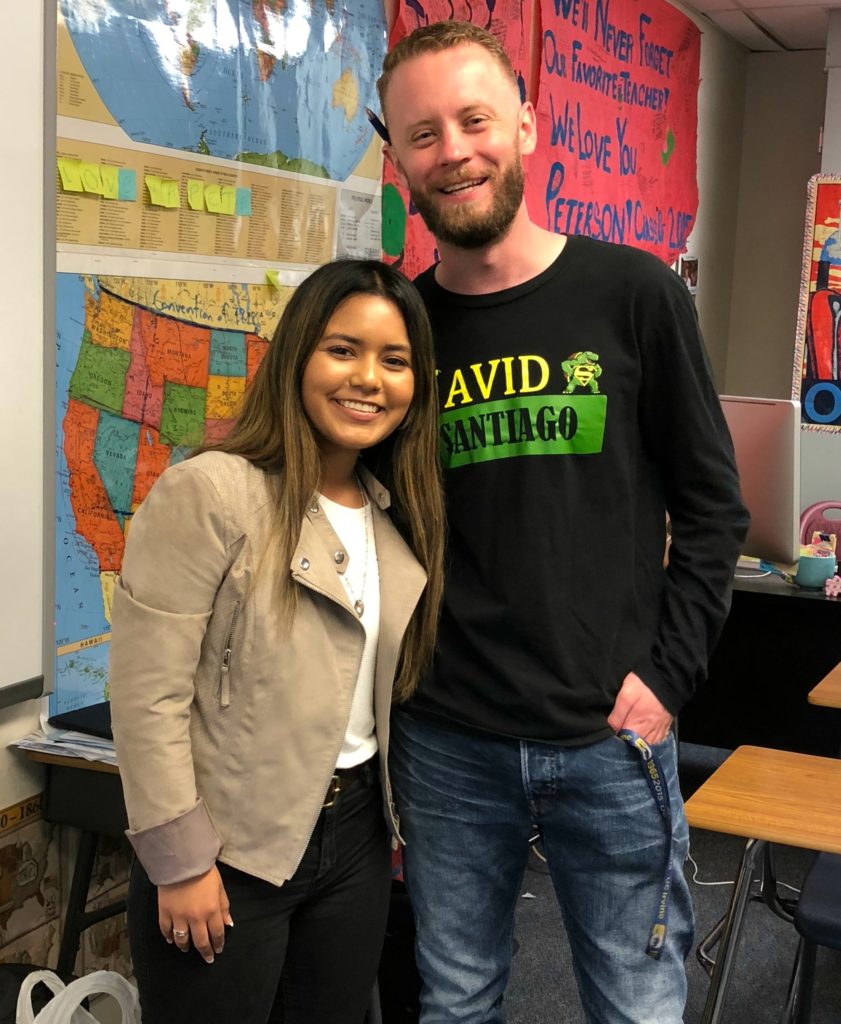On a bluff overlooking Omaha Beach, the Normandy American Cemetery holds the graves of 9,387 Americans, most of whom lost their lives in the D-Day invasion and ensuing operations.
Nearly 75 years later, a project coordinated by the non-profit National History Day organization seeks to tell the stories of these silent heroes by empowering a handful of student-and-teacher teams to conduct extensive research. One such pairing is from Orange County, and they’re about to embark on a months-long journey of investigation and discovery, culminating with a trip to Normandy, France.

“History is really important to me, and I’ve never been out of the country,” says Aubree Lopez, a junior at Foothill High School in the Tustin Unified School District. “So to travel and learn history at the same time is pretty cool.”
Lopez and her former social studies teacher, Erik Peterson of Santiago K-8 Elementary School in Santa Ana, are among 15 student-teacher duos chosen to participate in the 2018 Normandy: Sacrifice for Freedom Albert H. Small Student and Teacher Institute. The two will spend the better part of a year conducting in-depth historical research on a local fallen hero, relying on primary sources such as war records, draft cards and interviews with descendants.
Their subject is U.S. Army Pvt. Harold Latta, and while not much is known about him just yet, it appears he moved from Nebraska to Orange County shortly before he joined the war effort at age 19.
“I don’t get very emotional, but when I start reading things about him, I do,” Lopez says, noting that Latta’s story ended when he was just about two years older than she is now. “It makes me realize the reality of war and how much is at stake.”
Lopez says she learned of the institute through the National History Day website, and Peterson was her first choice to be her teacher-teammate. Together, the two built Santiago Elementary’s National History Day program when she was a middle school student, and they’ve continued to collaborate on NHD-related projects. Peterson still assists Lopez with her individual NHD entries, while Lopez continues to mentor Santiago students.
“She’s always been probably the biggest history buff that I know,” Peterson says. “I look forward to any opportunity to help support her goals of becoming a history major and getting into an elite university.”
The two applied for the program right around Thanksgiving and were told they’d been selected shortly before winter break. In recent weeks, they’ve crammed reading assignments and videos into their already hectic schedules.
“We’re learning something every week,” Peterson says. “It’s just exciting.”
In June, all of the teams will make their way to Washington, D.C. to complete their research with the help of historians and college professors, as well as access to the National Archives. They’ll also get to tour the World War II Memorial before prepping for the final leg of their journey to Normandy.
In France, they’ll get a chance to visit the beaches of D-Day, walking in the footsteps of those who fought valiantly for the liberation of Europe. Side trips to museums, historic battle sites and churches that were used as field hospitals are also on the agenda. Finally, they will make their way to the Normandy American Cemetery, where Lopez and the other students will deliver graveside eulogies for their respective Silent Heroes.
“This program is helping a new generation of Americans understand the sacrifice for freedom made during Operation Overlord,” says National History Day Executive Director Dr. Cathy Gorn. “Nothing relates the significance of the sacrifices made in Normandy better than a personal connection. Students become well acquainted with their Silent Heroes, often referring to them as a friend or family member.”
“The eulogies they deliver are often tear-filled, powerful, and incredibly moving,” she says.
To date, the institute has compiled stories for more than 100 Silent Heroes, creating digital memorials of their lives and service, and last year a teacher and student from University High School in Irvine were selected to participate. All of it has been made possible by veteran Albert H. Small, who donates funding for the courses, materials and travel expenses.
“These digital records of the life and actions of a Silent Hero will live on long after these teams return,” says Gorn. “They serve as a digital monument to the sacrifices made by the fallen.”
Including a local hero by the name of Harold Latta, whose story, at long last, is about to be told.
